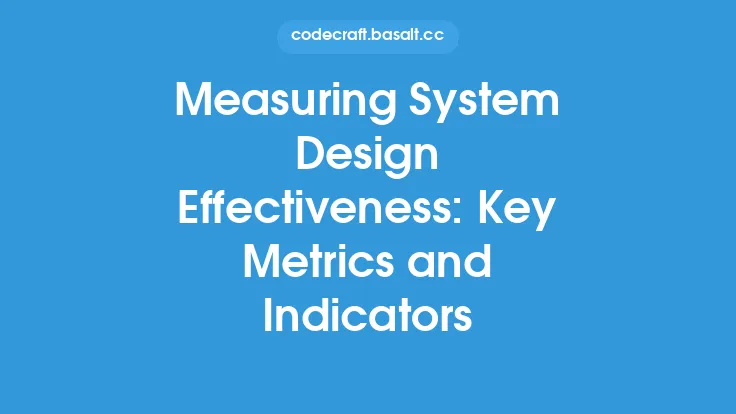Evaluating the performance of expert systems is a crucial step in ensuring that these systems operate effectively and efficiently. Expert systems are designed to mimic the decision-making abilities of a human expert in a particular domain, and their performance can have a significant impact on the outcomes of the decisions made. In this article, we will delve into the metrics and benchmarks used to evaluate expert system performance, providing a comprehensive overview of the key concepts and techniques involved.
Introduction to Evaluation Metrics
Evaluation metrics are used to assess the performance of expert systems, providing a quantitative measure of their effectiveness. These metrics can be broadly categorized into two types: quantitative and qualitative. Quantitative metrics are numerical in nature and provide a precise measure of performance, while qualitative metrics are more subjective and provide a descriptive assessment of performance. Some common quantitative metrics used to evaluate expert system performance include accuracy, precision, recall, and F1 score. Accuracy measures the proportion of correct decisions made by the system, while precision measures the proportion of true positives among all positive predictions made. Recall measures the proportion of true positives among all actual positive instances, and F1 score is the harmonic mean of precision and recall.
Benchmarking Expert Systems
Benchmarking is the process of comparing the performance of an expert system with that of other systems or with a set of predefined standards. Benchmarking provides a way to evaluate the performance of an expert system in a more comprehensive and meaningful way, allowing for the identification of areas for improvement and the comparison of different system designs. There are several benchmarking frameworks and methodologies available for expert systems, including the use of standard datasets and evaluation metrics. For example, the ROC (Receiver Operating Characteristic) curve is a commonly used benchmarking metric that plots the true positive rate against the false positive rate at different thresholds. This provides a visual representation of the system's performance and allows for the comparison of different systems.
Knowledge Base Quality Metrics
The knowledge base is a critical component of an expert system, and its quality can have a significant impact on the system's performance. Knowledge base quality metrics are used to evaluate the accuracy, completeness, and consistency of the knowledge base. Some common knowledge base quality metrics include knowledge base coverage, which measures the proportion of the domain that is covered by the knowledge base, and knowledge base accuracy, which measures the proportion of correct knowledge in the knowledge base. Other metrics, such as knowledge base consistency and knowledge base completeness, can also be used to evaluate the quality of the knowledge base.
Rule-Based System Evaluation
Rule-based systems are a type of expert system that uses a set of rules to make decisions. Evaluating the performance of rule-based systems requires the use of specialized metrics and benchmarks. Some common metrics used to evaluate rule-based systems include rule coverage, which measures the proportion of rules that are applicable to a given situation, and rule accuracy, which measures the proportion of correct decisions made by the rules. Other metrics, such as rule complexity and rule redundancy, can also be used to evaluate the performance of rule-based systems.
Explanation-Based Evaluation
Explanation-based evaluation is a type of evaluation that focuses on the ability of the expert system to provide clear and concise explanations for its decisions. This type of evaluation is particularly important in domains where transparency and accountability are critical, such as in medical or financial decision-making. Explanation-based evaluation metrics include explanation quality, which measures the clarity and concision of the explanations provided, and explanation completeness, which measures the proportion of decisions that are explained by the system.
Real-World Evaluation
Evaluating expert systems in real-world settings is critical to ensuring that they operate effectively and efficiently in practice. Real-world evaluation involves deploying the expert system in a real-world setting and evaluating its performance using metrics and benchmarks that are relevant to the specific application domain. This type of evaluation can provide valuable insights into the system's performance and can help to identify areas for improvement. Some common real-world evaluation metrics include user satisfaction, which measures the degree to which users are satisfied with the system's performance, and system usability, which measures the ease with which users can interact with the system.
Challenges and Limitations
Evaluating expert system performance can be challenging due to the complexity and nuance of the systems involved. Some common challenges and limitations include the difficulty of defining and measuring performance metrics, the need for large and high-quality datasets, and the potential for bias and variability in the evaluation process. Additionally, the evaluation of expert systems can be limited by the availability of resources, such as time, money, and expertise. To overcome these challenges, it is essential to use a combination of metrics and benchmarks, to carefully design and implement the evaluation process, and to continually monitor and refine the evaluation methodology.
Future Directions
The evaluation of expert system performance is an active area of research, and there are several future directions that are likely to shape the field. Some potential future directions include the development of new and more sophisticated evaluation metrics and benchmarks, the use of machine learning and artificial intelligence techniques to improve the evaluation process, and the integration of evaluation into the design and development process of expert systems. Additionally, the increasing use of expert systems in real-world applications is likely to drive the need for more comprehensive and nuanced evaluation methodologies, and the development of new standards and best practices for evaluation.





